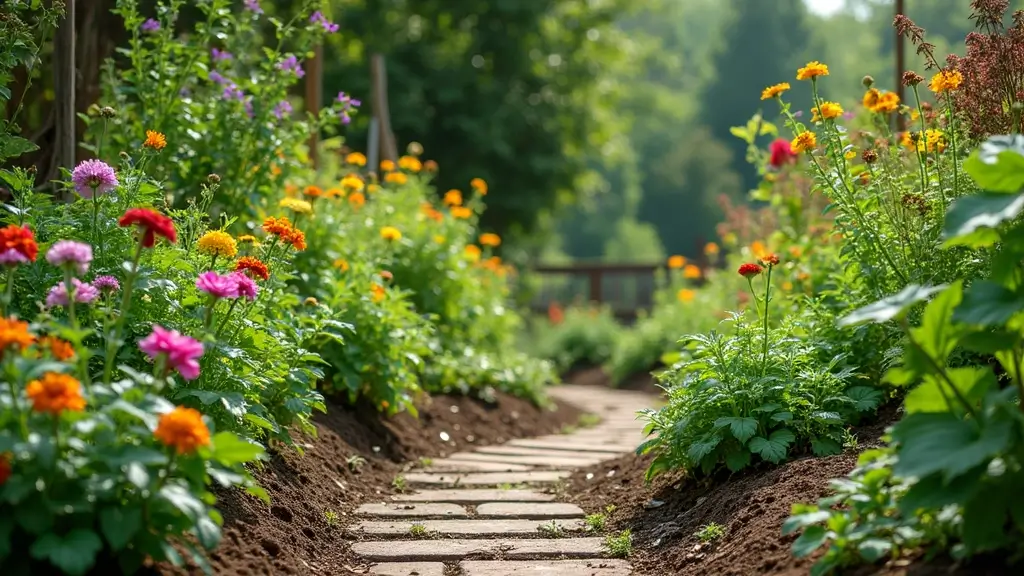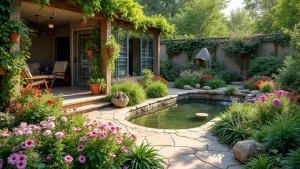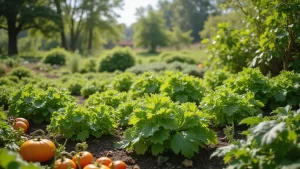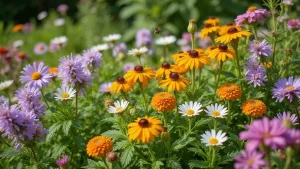10 Sustainable Gardening Practices That Will Transform Your Green Space Forever!
I started this post because I want gardens that give back. I want yards that drink less water and waste less energy. I want spaces that still bloom with life and joy. If you crave a space that feels calm, practical, and good for the planet, you’re in the right place.
Whether you have a balcony, a small urban plot, or a big backyard, this guide is for you. If you care about bees, soil health, and clean air, you will find it useful.
Here you’ll discover 10 sustainable gardening practices that are easy to try. They are practical, affordable, and fit into most spaces. You’ll learn how to save water, feed soil, and invite wildlife to your yard.
Start with simple steps like turning kitchen scraps into a small compost bin. Set up a rain barrel to catch rain and water your plants on dry days. Choose native or well-suited plants that thrive with less fuss. Mulch beds to keep soil cool and moist. Use natural pest tricks and beneficial insects to keep trouble away. Think about plant pairs and staggered blooms to feed pollinators all season.
These steps work best when you tailor them to your climate and space. Not every idea fits every garden, but you can mix and match. Start with one habit, see how it feels, then add another. Remember to check local rules for rain barrels or compost.
Ready to begin? Let’s make your green space friendly for people, plants, and wildlife. By the time you finish this guide, you will have a plan you can follow month by month. Let’s dive in and choose the first practice that fits your space.
1. Composting: The Gold of Gardening

Here is your new guide to composting. You want less waste and healthier soil. Composting turns kitchen scraps and yard leftovers into soil food. That soil feeds roots and helps plants grow.
Here is why this works. Microbes break down food scraps. The result is a dark, crumbly mix with a strong earthy smell.
Materials to gather
– Greens include vegetable peels, fruit scraps, coffee grounds, and fresh grass clippings.
– Browns include dry leaves, shredded paper, and cardboard.
Set up your space
Choose a shady, convenient spot in your yard. Use a compost pile or a bin. Aim for roughly equal parts green and brown by volume.
How to build it
Layer greens and browns. Keep the mix moist like a wrung sponge. Turn the pile every 1 to 2 weeks to add air and speed decay.
When is it ready?
After about 3 to 6 months you should see dark soil, a pleasant earth smell, and few recognizable scraps.
How to use
Sift the finished compost. Mix it into beds or use as a top dressing around plants.
What not to compost
Meat, bones, dairy, fats, weeds with seeds, diseased plants, and oily scraps should stay out.
Troubleshooting
If it smells bad, add dry browns and turn. If it is too dry, add scraps and water. If it is too wet, add browns and mix well.
Next steps
Start your first pile this weekend and watch your soil improve.
2. Rainwater Harvesting: Nature’s Gift

Rainwater Harvesting: Nature’s Gift
If you want a steady, low-cost water source for your garden, rainwater harvesting fits. Collect rain from your roof and use it to water beds, pots, and veggies. Rainwater is usually free of the chlorine and minerals in tap water, so it helps roots drink without harsh edits.
What you need
– A rain barrel or tank
– A downspout adapter to guide water into the barrel
– A fine mesh screen or lid
– A spigot for easy watering
– Optional: a simple first-flush filter to reduce debris
How to set it up
– Place the barrel under a downspout where it can catch clean runoff.
– Attach the diverter so rain goes into the barrel first, not the ground.
– Fit the screen or lid to stop leaves and mosquitos from breeding.
– Elevate the barrel on bricks or blocks for easy filling and a steady flow.
– Connect a spigot and, if you like, a short hose for quick watering.
Care and tips
– Shade the barrel to slow algae growth.
– Empty and rinse every few months to keep water fresh.
– In freezing spots, drain before the frost to avoid cracks.
– Keep the area clean so debris stays out of your water.
Next steps
You save money and help the planet. Quick setup, real rewards. Start with one barrel and watch your garden drink from nature’s clean source.
3. Native Plants: The Local Heroes

You want a garden that fits your climate and saves water. Native plants are your best bet. They are built for your area, so they use less water and less care than many non-native varieties.
They invite local pollinators like bees and butterflies. You get a lively, balanced yard as these bugs move through your space. And they look great, with colors and textures that feel right for your area.
– How to choose: Visit a nursery or check lists online. Look for plants labeled as natives.
– Quick tip: Pick species with similar water needs and sun exposure. That makes care simple.
Here is why this works: natives thrive in your soil setup and climate. They cope with droughts better and resist common pests. You’ll notice your garden become a hub for wildlife.
Next steps:
– Plant in groups of three to five. Big blocks help pollinators.
– Mulch and water early in the day to reduce evaporation.
– Add a small log or rock pile for shelter.
Be honest about limits. Natives may take time to fill in. Start with a small native bed and grow from there. You’ll beautify your space while helping biodiversity.
It pays off with less water use and a lively yard.
Choose native plants for your garden and watch it thrive! They save water, attract local pollinators, and are perfectly suited to your climate. Let nature’s best help you create a vibrant, sustainable green space!
4. Mulching: Nature’s Blanket

Mulching: Nature’s Blanket
Here is why you should use mulch. Let’s break it down. You want a garden that drinks less water and grows fewer weeds. Mulch does that. You may smell earthy notes as the mulch settles. It forms a soft shield on the soil. It cools the ground in heat and warms it in early spring. It feeds soil as it slowly breaks down.
– What to use: wood chips, straw, grass clippings, shredded leaves. These are cheap, easy to find, and kind to your plants.
– How to apply: spread a 2-3 inch layer around each plant. Keep mulch away from stems or trunks. A small gap helps air and water move.
– How it helps: it slows evaporation, reduces weed seeds, and keeps soil moist and evenly warm.
Next steps: prepare your bed, choose a mulch, and lay it down. Replenish the layer once a year so it keeps doing its job.
With mulch in place, your garden looks tidy and works easier. You’ll water less and weed less. Sound good?
Mulching is nature’s blanket for your garden! It conserves water, suppresses weeds, and enriches your soil. Embrace this sustainable gardening practice and watch your green space thrive, no matter the season!
5. Crop Rotation: Keep It Fresh

Crop Rotation: Keep It Fresh
You want a greener garden with less chemical work. Crop rotation helps you get that. It keeps soil alive and cuts pests the natural way.
– Plan first today. Draw a simple map of your beds on paper. Note which plant families grow where.
– Rotate a family, not a plant. Do not plant the same family in the same bed for at least three seasons.
– Set a clear three-bed plan. Label beds A, B and C. Move a group to the next bed each year.
– Try a simple layout. Bed A can hold leafy greens like lettuce and spinach. Bed B works well for beans or peas. Bed C is good for root crops like carrots and radish. Next year swap the groups so each bed rotates. If your space is small, start with two beds and expand later.
– Bonus: pair plants that help each other. Tomatoes near basil can boost flavor and may cut some pests.
Benefits that matter. Crop rotation feeds soil with different nutrients, which helps plants grow stronger. It reduces pests and disease by breaking their life cycles. It lowers the need for synthetic fertilizer and chemical sprays. You may see a steadier, bigger harvest over time.
Next steps. Start with a three-bed map today. Keep notes each season and adjust as you go. Your garden will thank you.
6. Organic Pest Control: Nature’s Allies

Pests nibble at leaves and bud tips. They can slow growth and push you to reach for harsh chemicals. You deserve a safe plan. Organic pest control gives you real options that work without toxins.
Here is why it helps: it protects pollinators, soil life, and your family. You can use simple products you already know.
– Natural sprays:
– Neem oil: mix per label, spray when bugs show first. Coat both sides of leaves.
– Insecticidal soap: dilute mild soap with water. Shake well. Apply on contact.
– Homemade soap spray: one teaspoon mild soap per quart water. Test on a leaf first.
– Friendly insects:
– Plant marigolds, yarrow, dill, and fennel. They attract ladybugs and lacewings that eat harmful pests.
– How to do it:
– Start with identification. Note the pest kind.
– Pick a method. Use oil or soap first.
– Apply in cool, calm moments. Morning or evening helps avoid leaf burn.
– Inspect after 24 hours. Reapply only if needed.
– Tips:
– Inspect your plants weekly for early signs.
– Test any new spray on a small area first.
– Avoid broad sprays that harm good insects.
Next steps: keep a simple garden journal. Track what pests show up and what works.
Some problems stay small with calm care. You can grow a resilient, safe garden this season.
7. Companion Planting: Friends in the Garden

You want a healthier garden without relying on chemicals. Companion planting can help you get more from your space with less work. It uses pairs of plants that support each other.
Here is why it works. Some plants guard others from pests. Some share soil nutrients. Some tame the microclimate around nearby crops. You plant them together to boost growth and cut problems.
How to get started
– Look over your beds. Note sun, soil, and space for each area.
– Pick 2 or 3 friendly pairs to test this season.
– Plant the pairs near each other. Watch what happens.
– Keep a simple garden journal to track what you notice.
Good plant pairings to try
– Tomatoes and basil. Basil can boost flavor and helps keep some pests away.
– Carrots and onions or chives. The onion family can help guard carrots from pests.
– Beans, corn, and squash. This trio helps the garden hum as a small team and makes use of space.
– Cucumbers and dill or nasturtiums. These helpers attract helpful insects and calm pests.
– Spinach with small aromatic herbs nearby. The aroma can help deter some pests.
What to avoid
– Don’t plant lettuce next to cabbage relatives. They compete for the same resources.
Practical tips you can use
– Start with a single bed and add one pair at a time. Keep changes simple.
– Mix in flowers that attract good insects. A few blooms can bring in beneficial bugs.
– Recheck each season. Some pairs work better in spring than in heat.
Next steps are simple. Plan your next round with these pairs in mind. Observe what grows best in your soil. Adjust your list after each harvest. With care, boosted yield and a richer garden await.
8. Perennial Gardening: Long-lasting Beauty

– You want a garden that keeps its beauty without wasting your weekends. Perennial gardening can deliver that.
– Perennials come back year after year. You plant once and enjoy many seasons of color. Fewer replanting chores save time and soil.
– Start with native perennials. They fit your climate and soil. They handle drought better and invite local pollinators. Once established, they sip less water and need less fuss.
– Plan by grouping plants with the same needs. Put sun lovers together and shade lovers together. Water-loving plants share a drip or soaker hose, while dry lovers thrive with less.
– Build blocks or swaths rather than single stems. This makes color, texture, and shape easy to notice. It also helps wildlife move through the bed.
– Add a sprinkle of seasonal annuals. They give quick color while your perennials settle. You get constant interest without extra digging.
– Mulch after planting. A 2-3 inch layer locks in moisture and slows weeds. Leave space around stems to prevent rot.
– Each year, trim back spent blooms and tidy dying leaves. Divide crowded clumps every few years to keep plants vigorous.
– With this approach, your garden grows with ease. Your space becomes a calm canvas that ages gracefully.
Plant once, enjoy forever! Embrace perennial gardening to create a stunning green space that thrives season after season with minimal effort.
| Practice | Materials/Tools | Cost | Benefits |
|---|---|---|---|
| Composting | Kitchen scraps, yard waste, compost bin | $31.99 (Compost Bin) | Reduces waste, enriches soil |
| Rainwater Harvesting | Rain barrel, downspout adapter, screen | $79.00 (Rain Barrel) | Conserves water, reduces water bills |
| Native Plants | Native plant seeds | $14.50 (Plant Guide) | Low maintenance, supports local wildlife |
| Mulching | Wood chips, straw, grass clippings | $39.99 (Mulch) | Retains moisture, suppresses weeds |
| Crop Rotation | Planting chart, seeds | $9.25 (Garden Planner) | Improves soil health, reduces pests |
| Organic Pest Control | Neem oil, insecticidal soap | $9.99 (Neem Oil) | Safe for pollinators, effective pest management |
| Community Gardening | Seeds, tools, shared space | N/A | Builds community, shares resources |
9. Green Manures: Soil Superfoods

Your soil looks tired after a long season. You want a simple fix that feeds it and keeps it covered. Green manures, or cover crops, grow fast and then go back into the ground. They add organic matter and pull in nutrients.
Here is why this works.
– What green manures are They are fast growing plants grown to cover soil. You cut them down and mix them back into the ground to feed the soil.
– What they do They stop erosion. They keep weeds down. They improve soil structure. They boost organic matter and feed soil life.
– Common choices Clover and vetch are popular. They fit many climates. For winter, rye or oats work well.
– How to use them Pick a crop that fits your season. Sow thickly in your beds. Let it grow for several weeks. Then cut it down and bury the green matter. Or till it in before it seeds.
– Tips for best results Try a small mix of species for a wider range of nutrients. Plant on a schedule. If flowers appear, you can leave a few to attract pollinators, but cut before it seeds.
– Bottom line Green manures build soil health and plant strength for the next season.
10. Community Gardening: Growing Together

Here is how you can grow with your neighbors and boost your yard at the same time. Here is why this helps you. If you want greener space and a more sustainable block, a community garden can help. You share space, save water, and pick up simple tricks you can use at home.
– Start with a plan. Talk with nearby neighbors about a shared plot or several small beds. Decide what to grow, who tends each bed, and how to share costs.
– Share and save. Bring in tools, seeds, and compost. When you trade what you have, you spend less and keep soil rich.
– Grow together, learn together. You will pick up tips on soil health, watering, and pest control. Use what you learn in your own yard.
– Build a friendly garden culture. You will meet neighbors, swap plants, and help kids see where food comes from. A group plot can feel like a small town patch that everyone helps.
– Keep it simple and fair. Create clear chores, harvest days, and safety rules. A simple calendar helps people show up on time.
With this setup you gain neighbors, hands-on skills, and a space you all help care for.
“Community gardening isn’t just about growing plants; it’s about growing friendships and a greener neighborhood. Together, we can cultivate sustainability one shared plot at a time!”
Conclusion: Your Path to a Greener Future

Embracing sustainable gardening practices is a rewarding journey for both you and the planet. Every small change you make can lead to significant impacts on environmental health and biodiversity.
As you implement these strategies, each visit to your garden will bring joy and fulfillment, knowing you’re contributing to a greener future. So grab your gardening gloves and start transforming your space today—there’s no time like the present to nurture both your garden and the Earth!
Frequently Asked Questions
What Are the Benefits of Composting in Sustainable Gardening?
Composting is like giving your garden a superfood boost! By recycling kitchen scraps and yard waste, you’re not only reducing landfill waste but also enriching your soil with essential nutrients.
This leads to healthier plants that require less water and chemical fertilizers. Plus, you’ll find yourself feeling more connected to nature as you create a closed-loop system in your garden!
How Does Rainwater Harvesting Contribute to Sustainable Gardening?
Rainwater harvesting is a fantastic way to embrace sustainability in your garden! By collecting rainwater from your roof, you can create a low-cost, eco-friendly irrigation system.
This practice not only conserves precious water resources but also helps you save money on your water bill while ensuring your plants stay hydrated and happy, even during dry spells.
Why Should I Choose Native Plants for My Garden?
Choosing native plants is like inviting local heroes to your garden party! These plants are perfectly adapted to your climate, which means they require less water and maintenance.
They also support local wildlife, providing food and habitat for birds, bees, and butterflies. By planting natives, you’re not just beautifying your space; you’re also contributing to local biodiversity!
What Is Companion Planting and How Can It Benefit My Garden?
Companion planting is like matchmaking for your garden! By pairing plants that support each other’s growth, you can create a healthier ecosystem without relying on chemical fertilizers.
For example, planting basil next to tomatoes can enhance flavor and repel pests. It’s a fun and effective way to maximize your garden’s productivity while keeping it eco-friendly!
How Can Community Gardening Enhance Sustainability Efforts?
Community gardening is a wonderful way to grow together and promote sustainability! By collaborating with neighbors, you can share resources, knowledge, and even harvests.
This not only strengthens community bonds but also reduces your carbon footprint. Plus, you’ll enjoy a vibrant green space that benefits everyone, making your neighborhood a healthier and more beautiful place to live!



